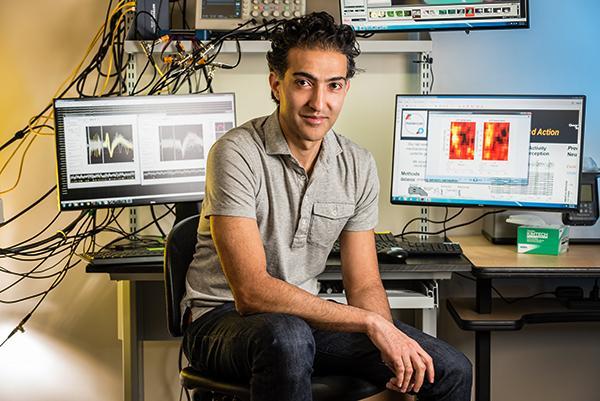Bilal Haider Awarded $2 Million NIH Grant
Jul 23, 2018 — Atlanta, GA

Bilal Haider, assistant professor in the Wallace H. Coulter Department of Biomedical Engineering at the Georgia Institute of Technology and Emory University
Bilal Haider, assistant professor in the Wallace H. Coulter Department of Biomedical Engineering at the Georgia Institute of Technology and Emory University and researcher in the Petit Institute for Bioengineering and Bioscience at Georgia Tech, was awarded a five-year, $2 million R01 grant from NIH to better understand the cerebral cortex. A thin sheet about two millimeters thick covering each brain hemisphere, the cortex is responsible for processing thought, perception and memory, and serves as the seat of advanced motor function, social abilities, language, and problem solving.
The brain processes sensory information very rapidly during behavior. Impairments in sensory processing characterize many debilitating neurological conditions such as schizophrenia, dementia, and autism, and there is a lack effective treatments for such disorders because scientists do not fully understand the principles of neuronal communication. Discovering these principles is a fundamental step towards lessening deficits common to many neurological disorders.
Haider’s lab will provide innovative measurements and analysis of the relationship between single neurons, synaptic activity, and large-scale neural networks in visual cortex during controlled perceptual behaviors in mice.
A major need exists to identify how synaptic and network mechanisms coordinate rapid electrical signaling in the cortex, and how these lead to normal and impaired sensory perception and behavior. A prevailing model of cortical function postulates that excitatory and inhibitory processes maintain an optimal balance that becomes disrupted during sensory impairments and neurodevelopmental diseases. Currently, there is little knowledge regarding how these excitatory and inhibitory signals are organized during sensory perception. These basic studies are needed to begin understanding how to repair the function of brain circuits in many neurological diseases.
“So much still remains unknown about the basic mechanisms of electrical communication in the cortex during normal sensory experience and sensory impairments,” said Haider. “Our goal with this work is to start performing detailed study of excitatory and inhibitory signaling in neural networks during visual perception, and we hope to understand what goes wrong in the cortex during moments of visual impairment. This project is a big vote of confidence not only for our approach, but for the greater importance of basic research into brain circuits from a neural circuits and engineering perspective.”
This project will fulfill a need to understand these processes in individual neurons, networks, and synaptic inputs during behavior, so that we may better comprehend how to rectify sensory processing deficits characteristic of many neurological and neurodevelopmental disorders.
Walter Rich




